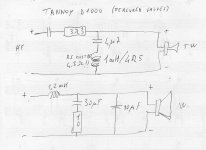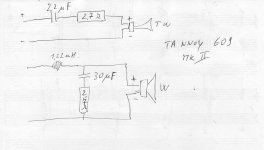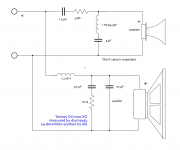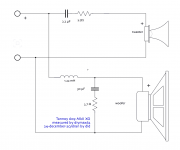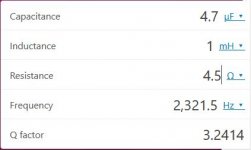Hello,
recently I've changed my mixig setup from a Lowther DX3 bass reflex unit to a Tannoy system. I've put my hands on a pair of DC1000 ones, I like their sound a lot and they are a reference better than my DX3 by far.
I don't want to say they sing better than the Lowther, for my tastes Lowther speakers reach a quasi unsurpassed level of details, but they must be "civilized" in a so hard way... Tannoy remains in the source point area (I can't renounce at this if I have to listen to mix for hours) without the Lowther's detail level but with a far better reference sound to evaluate the quality of a mix.
So, I opened the DC1000 to upgrade the crossover (especially substituting the electrolytc capacitors) and I have the opportunity to share the crossover schematics, with all value measured, with all the Tannoy lovers around, pointing the attention to a specification I never found in various schematics I've found on the net: the 1mH coil in series with the 4u7 capacitor that form together an anti-resonance attenuator placed in parallel with the tweeter MUST have a 4,5 Ohm RS (Resistance Series) value.
If you substitute it with a better coil you MUST reach 4,5 Ohm resistance adding the correct value to the RS of the coil itself, elsewhere che resonance cell won't work correctly.
I hope it will be a good advice for all the Tannoy aficionados!
Up with the music!
Max
recently I've changed my mixig setup from a Lowther DX3 bass reflex unit to a Tannoy system. I've put my hands on a pair of DC1000 ones, I like their sound a lot and they are a reference better than my DX3 by far.
I don't want to say they sing better than the Lowther, for my tastes Lowther speakers reach a quasi unsurpassed level of details, but they must be "civilized" in a so hard way... Tannoy remains in the source point area (I can't renounce at this if I have to listen to mix for hours) without the Lowther's detail level but with a far better reference sound to evaluate the quality of a mix.
So, I opened the DC1000 to upgrade the crossover (especially substituting the electrolytc capacitors) and I have the opportunity to share the crossover schematics, with all value measured, with all the Tannoy lovers around, pointing the attention to a specification I never found in various schematics I've found on the net: the 1mH coil in series with the 4u7 capacitor that form together an anti-resonance attenuator placed in parallel with the tweeter MUST have a 4,5 Ohm RS (Resistance Series) value.
If you substitute it with a better coil you MUST reach 4,5 Ohm resistance adding the correct value to the RS of the coil itself, elsewhere che resonance cell won't work correctly.
I hope it will be a good advice for all the Tannoy aficionados!
Up with the music!
Max
Attachments
Many thanks for posting this, I am sure many will find it over the coming months.
Are they easy to come by in Rome or did you have to wait for a pair to appear on the market?
Lowther DX3 to Tannoy co-axial interesting change.
Merry Christmas, if that is at all possible in these times.
Are they easy to come by in Rome or did you have to wait for a pair to appear on the market?
Lowther DX3 to Tannoy co-axial interesting change.
Merry Christmas, if that is at all possible in these times.
Hello Raymondj,
I've always been in love with Tannoy before to discover the Lowthers world, and sincerely I was quite suspicious about the Tannoy plastic cones series, but I have to say they are very good for near field monitoring.
I waited for something interesting on Ebay UK, in Italian market Tannoy is overestimated. in UK there are a lot of very interesting offers, and, obviously, the shipping cost is a lot cheaper of what I paid for.
I think the only obligatory thig to do is to change the electrolytic capacitors in the crossover, at least the ones in the tweeter path, then you can enjoy this little and inexpensive (at these days...) beauties.
In my opinion, let us to spread a Merry Christmas all around the world despite all troubles we're living, my friend, I think we all just need it.
Max
I've always been in love with Tannoy before to discover the Lowthers world, and sincerely I was quite suspicious about the Tannoy plastic cones series, but I have to say they are very good for near field monitoring.
I waited for something interesting on Ebay UK, in Italian market Tannoy is overestimated. in UK there are a lot of very interesting offers, and, obviously, the shipping cost is a lot cheaper of what I paid for.
I think the only obligatory thig to do is to change the electrolytic capacitors in the crossover, at least the ones in the tweeter path, then you can enjoy this little and inexpensive (at these days...) beauties.
In my opinion, let us to spread a Merry Christmas all around the world despite all troubles we're living, my friend, I think we all just need it.
Max
Thanks for posting your network and comparison to Lowther. If you ever get the chance to listen to the Tannoy Revolution Series XT Mini and also to the XT 6 they are amazing. I think the best DC that Tannoy has ever produced (I own both). A very Happy Christmas and a prosperous and healthy New Year to you and to all.
Hello, just to keep you informed about my exeriments to reach a good pair of NF monitor for mixing, I've set up a pair of boxes with Tannoy 609 MKII speakers, and I must say I like DC 1000 a lot in comparison, there's too much lack of "voice" in the 609 speakers and a tendency to the bright region.
I think not only I have to reach a good reference sound, but I have to hear to a monitor for hours, so it has to be "appealing" to hear and, yes, DC1000 are so.
The only thing I've noted is their tendency on the "warm" side (that I like a lot), that is driving me to a too bright mixing, so I'm trying to lower the tweeter series resistance, 1,5 Ohm seems a promising value.
To mantain the correct crossover frequency I'd have to compensate the series capacitor, too, due to the lower resistance af the combination tweeter + resistor, but I don't hear an audible dip in the middle/High region (a lower resistance drive to a higher FT with the same capacitor value).
I repeat, it's not to "correct" DC1000 sound, that is a very, very nice one as in the original project, it's just to save me from the bright tendency while mixing.
In the same time, I'll try to work on the 609 crossover to compensate the lack of voice and to calm the high region, even if I have to say that they seems quite different speakers, and 609 seems to fall in a more commercial field. It's only a first impression, maybe I can be wrong.
If someone is interested in I can post the schematics of 609 MKII crossover, too, with measured value (obviously)...😀
I think not only I have to reach a good reference sound, but I have to hear to a monitor for hours, so it has to be "appealing" to hear and, yes, DC1000 are so.
The only thing I've noted is their tendency on the "warm" side (that I like a lot), that is driving me to a too bright mixing, so I'm trying to lower the tweeter series resistance, 1,5 Ohm seems a promising value.
To mantain the correct crossover frequency I'd have to compensate the series capacitor, too, due to the lower resistance af the combination tweeter + resistor, but I don't hear an audible dip in the middle/High region (a lower resistance drive to a higher FT with the same capacitor value).
I repeat, it's not to "correct" DC1000 sound, that is a very, very nice one as in the original project, it's just to save me from the bright tendency while mixing.
In the same time, I'll try to work on the 609 crossover to compensate the lack of voice and to calm the high region, even if I have to say that they seems quite different speakers, and 609 seems to fall in a more commercial field. It's only a first impression, maybe I can be wrong.
If someone is interested in I can post the schematics of 609 MKII crossover, too, with measured value (obviously)...😀
Last edited:
"Quote" If someone is interested in I can post the schematics of 609 MKII crossover, too, with measured value (obviously)...
Please do it is always good to have such data out there and the more who download it the better to insure it's availability. Thank you and Merry Christmas.
Please do it is always good to have such data out there and the more who download it the better to insure it's availability. Thank you and Merry Christmas.
Sure, here we are: schematic in attachment.
Probably the lack of voice is dued to the lowpass filter, a 30uF, even with the 2,7 Ohm resistor in series, seems a "brute" value to follow a 1,2 mH coil. I consider more interesting the DC 1000 crossover, where the 30 uF capacitor in series with the 10 Ohm resistor act practically as a inductance compensation and the real filter cell is done with the 1,2 mH coil and 10 uF capacitor.
Also the antiresonance cell on the tweeter disappeared, I can imagine because of the new tweeter, surely not for economical reason.... does it? I'll investigate on it, too...
A very Merry Christmas to you all,
Massimo
Probably the lack of voice is dued to the lowpass filter, a 30uF, even with the 2,7 Ohm resistor in series, seems a "brute" value to follow a 1,2 mH coil. I consider more interesting the DC 1000 crossover, where the 30 uF capacitor in series with the 10 Ohm resistor act practically as a inductance compensation and the real filter cell is done with the 1,2 mH coil and 10 uF capacitor.
Also the antiresonance cell on the tweeter disappeared, I can imagine because of the new tweeter, surely not for economical reason.... does it? I'll investigate on it, too...
A very Merry Christmas to you all,
Massimo
Attachments
Looks very similar to what's found in the Saturn S8 series.Sure, here we are: schematic in attachment.
Probably the lack of voice is dued to the lowpass filter, a 30uF, even with the 2,7 Ohm resistor in series, seems a "brute" value to follow a 1,2 mH coil. I consider more interesting the DC 1000 crossover, where the 30 uF capacitor in series with the 10 Ohm resistor act practically as a inductance compensation and the real filter cell is done with the 1,2 mH coil and 10 uF capacitor.
Also the antiresonance cell on the tweeter disappeared, I can imagine because of the new tweeter, surely not for economical reason.... does it? I'll investigate on it, too...
A very Merry Christmas to you all,
Massimo
Hello Dave, you're right, I forgot to mention it: it's a 1,5 uF one.
In the meantime I've changed the 609 low pass crossover accordigly to the DC 1000 schematics, and it seems absolutely better. The speaker recovered a lot of voice and warm presence (let's say 800-1K region, I suppose).
Now I have to calm an excessive mid-high presence in the tweeter (probably 2÷3 KHz), it looks like to take great advantage from the DC 1000 schematics, too (but surely is a different tweeter, it will be a lot of work to do...)
To be sincere it seems to me that the market approach in last years seems to follow the dramatic detriment of quality due to the "winner of losers" Mp3 format.
I'll be 59 in exact two weeks, and despite my age I don't feel any kind of needing of this exagerate hyper definition, especially if the starting information are approximative or wrong...
To be continued...😀😀
In the meantime I've changed the 609 low pass crossover accordigly to the DC 1000 schematics, and it seems absolutely better. The speaker recovered a lot of voice and warm presence (let's say 800-1K region, I suppose).
Now I have to calm an excessive mid-high presence in the tweeter (probably 2÷3 KHz), it looks like to take great advantage from the DC 1000 schematics, too (but surely is a different tweeter, it will be a lot of work to do...)
To be sincere it seems to me that the market approach in last years seems to follow the dramatic detriment of quality due to the "winner of losers" Mp3 format.
I'll be 59 in exact two weeks, and despite my age I don't feel any kind of needing of this exagerate hyper definition, especially if the starting information are approximative or wrong...
To be continued...😀😀
WOW!! Great work!! please planet10 pay attention to the resistor in series with the 30uF capacitor (both in parallel with the 609's woofer): its value is 2,7 Ohm, not 27 Ohm, exactly the same of the one in series with the tweeter.
Just for curiosity I've found a rcl net calculator on internet, I've entered the value of the resonant cell in parallel with the DC1000's tweeter, its resonance frequency is centered at around 2320 Hz (...hmmm so it seems I heard right... 😀), with a q of 3,2 (about 1/2 octave), it should affect exactly the 2÷3KHz region, I absolutely have to give it a try inserting into the 609's cross, too...
Just for curiosity I've found a rcl net calculator on internet, I've entered the value of the resonant cell in parallel with the DC1000's tweeter, its resonance frequency is centered at around 2320 Hz (...hmmm so it seems I heard right... 😀), with a q of 3,2 (about 1/2 octave), it should affect exactly the 2÷3KHz region, I absolutely have to give it a try inserting into the 609's cross, too...
Attachments
Last edited:
Edit: 2nd diagram fixed
...perfect!! I'll save them in my collection instead of my scribbles 😀😀

I am resurrecting my trusty old DC-1000s and would like to run a simulation, I have looked for the driver operational curves/specs and FRD/ZMA files/info without much success. can any anyone please help me located this info? Thank you.
Hello DC1000 aficionados! I just measured the T/S parameters of both speakers. It seems interesting to me the little bump in the 2÷3 KHz region of the tweeter, exactly the same range where the rcl cell works.
About the woofer, I have to say I'm a little bit surprised by the relatively high fs, but maybe it's the price to pay for the midrange quality ina 20 cm woofer. Despite its "2ways" concept, the midrange are really pleasant (I think that the 6dB/oct. hipass have its role on this feature).
Happy DC1000 to all audio friends!
About the woofer, I have to say I'm a little bit surprised by the relatively high fs, but maybe it's the price to pay for the midrange quality ina 20 cm woofer. Despite its "2ways" concept, the midrange are really pleasant (I think that the 6dB/oct. hipass have its role on this feature).
Happy DC1000 to all audio friends!
Attachments
Last edited:
Hello Massimo
this is great info, thank you for taking the time to post this information, not much can be found on the actual parameters of this particular tannoy driver. Ciao e grazie.
this is great info, thank you for taking the time to post this information, not much can be found on the actual parameters of this particular tannoy driver. Ciao e grazie.
Impedance resonance compensator for DC1000
Hi Massimo (et al)
thanks again Massimo for posting this information, I had a chance to do some simple calculations for the tweeter impedance compensator circuit for the DC1000, which as you guys have posted is a 1mH and 4.7uf cap with a R of 4.5 ohms, in this case the R of the inductor. As you well point out, the frequency of the LC is in the 2300 Hz area which coincides with the smaller hump on the graph, but the R at 4.5 ohms does not map into the data measured. Perhaps my equations are incorrect 😕, I am using R = Rr * Re / (Rr - Re). For the Re and Zmax measured this yields around 11 ohms, if I use the smaller hump Zmax then is even higher. Can you help me make sense of this R value? thank you all.
Hi Massimo (et al)
thanks again Massimo for posting this information, I had a chance to do some simple calculations for the tweeter impedance compensator circuit for the DC1000, which as you guys have posted is a 1mH and 4.7uf cap with a R of 4.5 ohms, in this case the R of the inductor. As you well point out, the frequency of the LC is in the 2300 Hz area which coincides with the smaller hump on the graph, but the R at 4.5 ohms does not map into the data measured. Perhaps my equations are incorrect 😕, I am using R = Rr * Re / (Rr - Re). For the Re and Zmax measured this yields around 11 ohms, if I use the smaller hump Zmax then is even higher. Can you help me make sense of this R value? thank you all.
Hello Miguel,
sorry I'm not into mathematic so I can't help with your calculations, but just note that the rlc net is placed in parallel after the series attenuator resistor, so it should act as a variable attenuator vs frequency with the minimum value centered in the resonance area, lowering the power that goes to the tweeter. I've found an online rlc calculator, for this net it gives me 4,5 Ohm at 2,3 KHz and 8,7 Ohm at 1,8 KHz and 3 KHz. Higher value far from the resonance area (e.g. 46 Ohm at 8 KHz) shouldn't affect too much the signal that goes to the tweeter. I repeat, mathematic is not my field, but this makes sense to me, hope this helps.
sorry I'm not into mathematic so I can't help with your calculations, but just note that the rlc net is placed in parallel after the series attenuator resistor, so it should act as a variable attenuator vs frequency with the minimum value centered in the resonance area, lowering the power that goes to the tweeter. I've found an online rlc calculator, for this net it gives me 4,5 Ohm at 2,3 KHz and 8,7 Ohm at 1,8 KHz and 3 KHz. Higher value far from the resonance area (e.g. 46 Ohm at 8 KHz) shouldn't affect too much the signal that goes to the tweeter. I repeat, mathematic is not my field, but this makes sense to me, hope this helps.
Just to underline the importance of the 4,5 OHm resistor, even if a R component of the coil: without it, imagining a 0,2 Ohm value for the coil, the rlc resistance at 2,3 KHz would be lower than 0,5 Ohm. Even considering the 2,7 Ohm series resistor, the amplifier would see around 3 Ohm impedance (in parallel with the value of the woofer net at that frequency)... not very kind for the amplifier...
- Home
- Loudspeakers
- Multi-Way
- About Tannoy DC1000 crossover
